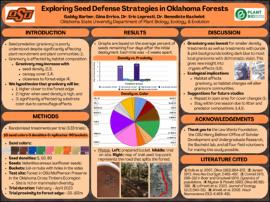| dc.contributor.advisor | Bachelot, Benedicte | |
| dc.contributor.author | Barber, Gabby | |
| dc.contributor.author | Errico, Gina | |
| dc.contributor.author | Lopresti, Eric | |
| dc.contributor.other | Wentz Research Scholars | |
| dc.date.accessioned | 2023-05-15T20:28:06Z | |
| dc.date.available | 2023-05-15T20:28:06Z | |
| dc.date.issued | 2023-04-27 | |
| dc.identifier | oksd_wentz_2023_barber | |
| dc.identifier.citation | Barber, G., Errico, G., Lopresti, E., et al. (2023) Exploring the ecological implications of seed defense strategies in Oklahoma forests. Poster session presented at the Oklahoma State University Wentz Research Scholars Symposium, Stillwater, OK. | |
| dc.identifier.uri | https://hdl.handle.net/11244/337695 | |
| dc.description.abstract | An important but often overlooked topic in plant community research explores bottlenecks to plant recruitment and survival due to seed predation (granivory). Often, granivory has a higher impact on seedling survival than microsite conditions or pathogens. Little is known about the various and intertwined factors by which granivores choose to consume seeds, which this ongoing study addresses by analyzing three factors. One factor is habitat proximity; predator dynamics change relative to the forest edge, but few studies analyze these effects on granivory. Another factor is seed density in the context of the Janzen-Connell (J-C) hypothesis, which explains that herbivores selectively prey on seeds and seedlings closer to conspecific adults. The last factor is crypsis, which can allow seeds to be visually overlooked by predators. | |
| dc.description.abstract | Aim 1: How does seed crypsis affect density-dependent seed predation? Aim 2: How does seed crypsis interact with density and habitat proximity to affect granivory? Hypothesis 1: Camouflaged seeds will allow them to go unnoticed by predators leading to removal rates that follow J-C patterns, thereby exhibiting negative density dependence. Hypothesis 2: Removal rates of seeds closer to the forest edge will be significantly different from those further from the forest edge. | |
| dc.description.abstract | The study design consists of two trials of 90 open buckets with Helianthus annuus seeds and sand. Each trial accommodates 3 replicates of 2 treatment groups: 3 seed density groups to test density dependence and 10 sand colors to test crypsis. The first 45 buckets represent the first half closest to the forest edge. Buckets were deployed in the winter and spring of 2022-2023 and were visited daily to monitor seed removal until all seeds are gone. We found that there was significantly less predation in lower-density treatments and that there was less predation against purple and pink backgrounds. We did not observe any differences between proximity treatments. | |
| dc.description.sponsorship | Lew Wentz Foundation | |
| dc.format | application/pdf | |
| dc.language | en_US | |
| dc.publisher | Oklahoma State University | |
| dc.rights | In the Oklahoma State University Library's institutional repository this paper is made available through the open access principles and the terms of agreement/consent between the author(s) and the publisher. The permission policy on the use, reproduction or distribution of the article falls under fair use for educational, scholarship, and research purposes. Contact Digital Resources and Discovery Services at lib-dls@okstate.edu or 405-744-9161 for further information. | |
| dc.title | Exploring the ecological implications of seed defense strategies in Oklahoma forests | |
| osu.filename | oksd_wentz_2023_barber.pdf | |
| dc.description.department | Plant Biology, Ecology, and Evolution | |
| dc.type.genre | Poster | |
| dc.type.material | Text | |
| dc.type.material | Image | |
| dc.subject.keywords | herbivory | |
| dc.subject.keywords | granivory | |
| dc.subject.keywords | ecology | |
| dc.subject.keywords | predation | |
| dc.subject.keywords | seed | |
